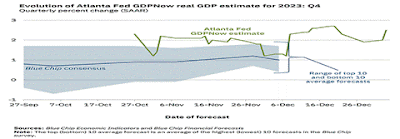Prospects for better fourth quarter economic growth are improving. Why? Interest rates are declining along with inflation rates.
In fact, I mentioned last week that the rate of U.S. inflation based on the Federal Reserve’s preferred PCE index became negative in November for the first time since 2020 indicating that price pressures continue to subside. The PCE index actually dipped – 0.1 percent last month, the government said Friday, and was unchanged in October.
The Atlanta Fed’s GDPNow Q4 estimate of economic growth that I like just picked up steam after several downward revisions.
“The GDPNow model estimate for real GDP growth (seasonally adjusted annual rate) in the fourth quarter of 2023 is 2.5 percent on January 3, up from 2.0 percent on January 2. After this morning’s release of the ISM Manufacturing Index from the Institute for Supply Management, the nowcasts of fourth-quarter gross personal consumption expenditures growth and fourth-quarter gross private domestic investment growth increased from 2.4 percent and -0.4 percent, respectively, to 2.9 percent and 0.5 percent,” said its report.”
Boosting growth is consumer spending holding up with robust holiday shopping, and soaring construction spending, up 11.3 percent annually.
Why? It’s mostly the Infrastructure and Inflation Reduction Acts pairing with private industry in modernizing the American economy that is creating high-paying jobs and producing more things, which also brings down inflation.
There’s more spending on highways and bridges, while private residential construction rose 1.1 percent in November, with single-family construction up 2.9 percent and multi-family construction rising 0.1 percent. These are longer term investments which should mean longer term growth prospects.
On the inflation front stocks and bonds have been rallying because Chairman Powell sounded dovish for the first time at his December press conference following their last FOMC meeting of the year.
“The question of when it will be appropriate to begin dialing back the policy restraint” was clearly “a discussion for us at our meeting today,” Powell said. The Fed is “likely at or near the peak rate for this cycle.”
Plunging interest rates are best illustrated by the 10-year benchmark fixed rate Treasury note yield that sets mortgage rates. It had dropped below 4 percent for the first time since the pandemic.
And the 30-year fixed-rate mortgage fell for the seventh week in a row, averaging 6.61 percent as of Dec. 28, according to data released by Freddie Mac on Thursday. A year ago, the 30-year fixed-rate mortgage was averaging at 6.31 percent.
What’s not to like about prospects for growth in the New Year? Would congress be so foolish as to close down government because so much is on the line? I don’t think so.
Harlan Green © 2024
Follow Harlan Green on Twitter: https://twitter.com/HarlanGreen



No comments:
Post a Comment